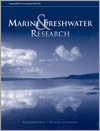Marine and Freshwater Research
Volume 73
Number 5 2022
Finlayson et al. (2021) proposed future management pathways for the Lower Lakes of the Murray–Darling Basin, including changed barrage operations to facilitate increased tidal exchange. Under current reduced inflows, this could create high risks to the freshwater ecological values of this Ramsar-listed wetland. The Lower Lakes can be sustained as healthy freshwater wetlands of international importance well into the future.
A paper published recently in Marine and Freshwater Research criticises a paper of mine, also published in Marine and Freshwater Research, which questioned the conclusion of an earlier study that effects of salinity on salt-sensitive stream invertebrates were substantially modified by interspecific biotic interactions with salt-tolerant organisms from a high-salinity stream. The present contribution responds to the criticism and reinforces my previous concerns.
The most parsimonious explanation of the results from a mesocosm experiment (Bray et al. 2019, doi:10.1098/rstb.2018.0020; Kefford et al. 2022, doi:10.1071/MF21164) is that the effect of salinity on macroinvertebrates was altered by organisms from a high-salinity site. This explanation is consistent with ecological and ecotoxicological theory. An alternative explanation (Chessman 2022, doi:10.1071/MF21314) is not parsimonious nor consistent with theory.
Spatial indices for monitoring marine species’ distributional changes have been calculated with fishery-independent survey data but are novel in terms of adoption with fishery-dependent data from the recreational sector. This study demonstrated and assessed the value of utilising such indices with boat-based recreational fishing data to identify areas of high activity and changes over time, with the aim to sustainably manage multispecies fisheries.
Fishery managers require knowledge of the ecology of species to make decisions. Studying the feeding habits of sharks is one way to learn about their ecology. This study focused on three shark species incidentally caught by prawn trawlers in Papua New Guinea. The diets of each species were characterised from stomach contents.
Here we describe a field-based study and a glasshouse experiment where we investigated the relationship between seed germination and seedling establishment of Acacia stenophylla (river cooba) and hydrological conditions. Seedlings were more likely to occur at sites more recently flooded. Seeds of A. stenophylla disperse within their pods, by hydrochory, and seed germination occurs in response to extended contact with moisture (>20 days).
The transition from pelagic to benthic habitat can be a challenge for marine organisms, especially those living in oceanic islands. The wrasse, Pseudolabrus gayi, from Robinson Crusoe Island, South Pacific, lives for 44 days as part of the zooplankton and then settles at ∼19 mm in length. After settlement, wrasse grows slowly (0.09 mm day−1), and its shape varies from robust with ventrally oriented mouth to slender with a frontally oriented mouth. However, the phenotype variation in body shape and early life-history traits vary asynchronously during this transition.
Our work brings information on sea turtle strandings in north-eastern Brazil (data collected from 2010 to 2019). Our study focused mainly on quantify strandings with signs of anthropogenic interaction; identify anthropogenic impacts on sea turtles; investigate impacts of economic activities on sea turtle strandings; evaluate the spatial-temporal distribution of sea turtle strandings with signs of anthropogenic interaction; and analyse possible relation between socioeconomic conditions of nine coastal municipalities and sea turtle strandings with signs of anthropogenic interaction.
The introduction of non-native species is one of the major threats to fish ecology and studies on how introduced predators affect native predators are poorly understood. We assessed the reproductive biology of thrairas in scenarios, with and without non-native fish. Results indicated differences in life-history traits of thrairas influenced by the environmental pressures associated with the introduction.
The study provided evidence of the ecological benefits of using circle-hooks in tuna pole-and-line with artificial light (PL) fisheries. The catch rate of sea turtle was 0.18 for C-hooks and 0.52 for JT-hooks. The catch of PL fishery was highly affected by spatial and temporal conditions such as month, lunar phase, and amount of light power used.
Few studies have explored trophic ecology of sympatric elasmobranchs within nurseries. Here, we used stable isotope analysis to investigate the trophic interactions of two juvenile stingray species within a coastal communal nursery of the Great Barrier Reef. Our results provide evidence of niche partitioning between stingrays, likely reflecting differences in feeding grounds or prey selection, and also suggest that mangrove-derived carbon had little importance to stingrays’ diets.
One management strategy to make artificial lights less attractive to dispersing turtle hatchlings is to reduce light intensity. We tested the effectiveness of this strategy by examining the early dispersal and predation rates of flatback turtle hatchlings in relation to a range of intensities of light emitting diodes (LEDs). Our study showed that only the highest intensity light (120 W) influenced hatchling movement, and there was some evidence to suggest that the presence of LEDs negatively affected the survivorship of hatchlings passing through the nearshore.
Nitrogen is a key nutrient that controls primary production in coastal ecosystems. Nitrogen budgets are used to understand the relative importance of different sources. Here, we present a nitrogen budget constrained by using isotopes for Western Port, Australia
The movements of small fishes are increasingly being monitored by high-frequency acoustic telemetry transmitters. This study was conducted to better understand how far these transmitters can be detected in marine habitats to help interpret fish movements. Detection ranges were >100 m in mangrove and transitional estuarine habitats, highlighting the effectiveness of these tags in specific marine habitats.





